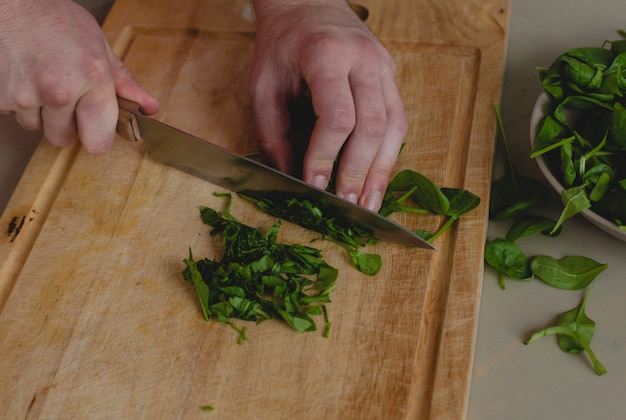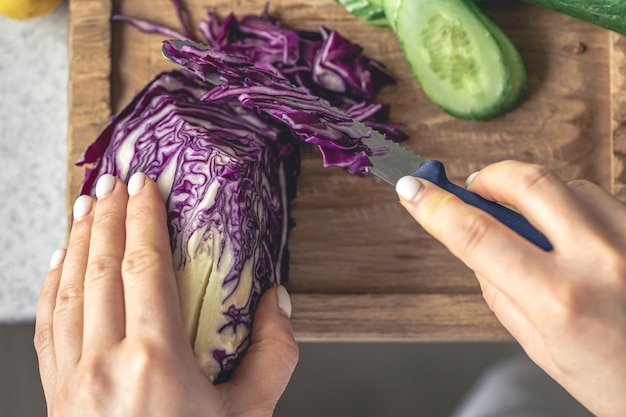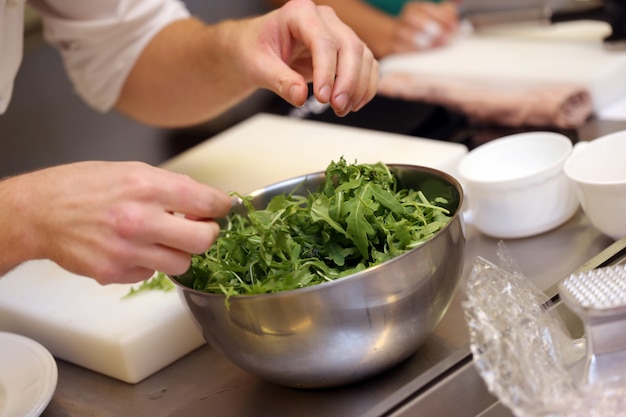Let's face it, collard greens aren't exactly the first thing that springs to mind when you think of "delicious." They're often relegated to the back of the fridge, overshadowed by their more glamorous leafy green cousins. But believe me, once you discover the magic of perfectly cooked collard greens, you'll be singing their praises from the rooftops.
This guide is your one-stop shop for all things collard greens. We'll explore everything from choosing the best bunch at the market to mastering the art of prepping, cooking, and serving them with style. We'll even delve into the nutritional benefits and address those pesky questions that may have been holding you back from embracing this humble yet mighty green.
Get ready to experience a whole new world of collard green goodness. It's time to ditch the preconceived notions and unlock the true potential of this amazing vegetable!
(Part 1) Finding the perfect collard greens

Before embarking on your culinary journey with collard greens, it's crucial to start with the right ingredients. Just like you wouldn't use subpar paint for a masterpiece, you wouldn't want to start cooking with lackluster collards.
Picking the Perfect Bunch: A Guide for the Discerning Cook
The next time you're at the market, take a moment to truly appreciate the beauty of a perfect bunch of collard greens. Here's what you should look for:
Vibrant Green Hue: The leaves should be a deep, rich green, signifying freshness and vitality. Avoid any that look pale, yellowed, or wilting.
Crisp and Firm: The stems should be sturdy and resilient, not limp or easily bendable. This indicates a healthy plant that has been carefully harvested.
Immaculate Condition: The leaves should be free of holes, tears, or any discoloration. A blemish-free bunch is a sign of quality and care.
My Personal Tip:
I always like to check the leaves for any signs of pests. Little critters love collard greens, so you want to be sure your bunch is free of any unwanted guests. A quick visual inspection will ensure a pest-free culinary experience.
(Part 2) Prepping Collard Greens Like a Pro

You've got your perfect bunch of collard greens, now it's time to transform them into culinary magic.
Cleaning and Trimming: A Step-by-Step Guide
Washing: Collard greens are known for clinging onto dirt and debris, so a thorough wash is essential. I like to soak them in a sink of cold water for a few minutes, then give them a good rinse, making sure to remove any lingering debris. You can even add a pinch of salt to the water to help loosen any dirt that's clinging to the leaves.
Trimming the Stems: The stems of collard greens can be quite tough, so removing them is crucial for achieving a tender and enjoyable texture. Here's a simple trick: Start by removing the thickest part of the stem. Then, gently pull back the leaves to reveal the thinner stem that runs down the middle. Use a sharp knife to trim that stem as well. You can even gently tear the leaves off the stem if it's easier for you.
Cutting and Chopping: Creating Bite-Sized Bliss
Once the stems are removed, it's time to cut the leaves into bite-sized pieces. The size of your cuts is up to your preference. For a less chunky texture, I like to stack the leaves, then roll them up tightly. Then, I cut the roll into thin slices. This technique creates a more delicate texture that melts in your mouth.
Storing Leftover Greens: Keeping the Goodness Fresh
If you're not using all of your collard greens right away, store them properly to ensure they stay fresh and delicious. Wrap the washed and trimmed leaves in a paper towel and place them in a plastic bag. Keep them in the refrigerator for up to 5 days.
(Part 3) cooking collard greens: A culinary adventure

This is where the real magic happens! There are countless ways to cook collard greens, but I'm going to share my personal favourite method, which yields a truly flavourful and satisfying result.
My Go-To Method: Smoky, Savoury, and Simply Divine
I love cooking collard greens with a touch of smoky flavour. It adds a depth and richness that takes them to a whole new level. Here's how I do it:
Sautéing: Heat a generous amount of olive oil in a large pot over medium-high heat. The oil should be shimmering, not smoking. Add a sliced onion and a couple of cloves of minced garlic to the pot and cook until softened. The onions should become translucent and the garlic fragrant.
Adding the Greens: Toss in your chopped collard greens and stir to combine with the onions and garlic. You want to coat the greens in the oil and aromatics. Cover the pot and allow the greens to wilt for about 5 minutes, stirring occasionally. This helps to break down the leaves and create a more tender texture.
Seasoning with Love: Add a good pinch of salt, black pepper, and your favourite smoked paprika. I also love to add a dash of cayenne pepper for a bit of heat. Don't be shy with the seasonings, as they will permeate the greens and create a truly flavourful dish.
Simmering to Perfection: Add about 2 cups of vegetable broth to the pot and bring to a simmer. Cover and cook for about 30 minutes, stirring occasionally, until the greens are tender. You want the leaves to be soft and pliable, but still retain a slight bite.
(Part 4) Beyond the Basics: Experimenting with Flavours
Collard greens are like a blank canvas, begging to be transformed with exciting flavours.
Adding Depth of Flavor: A Symphony of Taste
Smoked Meats: A splash of smoked ham hock broth or a few chunks of smoked turkey adds a rich, smoky depth that elevates the dish. The smokiness complements the earthy flavour of the greens and creates a truly decadent dish.
Aromatic Spices: Try experimenting with spices like cumin, coriander, or even a pinch of ginger for a hint of warmth. These spices add complexity and depth to the flavour profile, creating a truly unique dish.
Citrus Burst: A squeeze of lemon or orange juice adds a vibrant acidity that complements the richness of the greens. The citrus brightens up the dish and balances the earthiness of the collards.
Adding Texture: A Culinary Contrast
Toasted Nuts: A handful of toasted pecans or walnuts adds a satisfying crunch and a boost of nutty flavour. The nuts provide a textural contrast to the soft greens and add a nutty dimension to the dish.
Dried Fruits: A few chopped dates or raisins offer a touch of sweetness that contrasts beautifully with the savouriness of the greens. The dried fruits add a hint of sweetness and a chewy texture that complements the greens perfectly.
Spicy Kick: Red pepper flakes, a dash of hot sauce, or a sprinkle of chili powder will give your greens a fiery kick. These additions add a touch of heat that awakens the taste buds and adds an element of excitement to the dish.
Alternative Cooking Methods: Expanding Your Culinary Repertoire
Steaming: If you prefer a lighter, more delicate flavour, try steaming your collard greens instead of simmering them. Simply place them in a steamer basket over boiling water for about 15-20 minutes. Steaming preserves the nutrients and brightens the colour of the greens.
Baking: For a hands-off approach, bake your collard greens in the oven. Toss them with olive oil, seasonings, and a little bit of broth, and bake at 350°F for 30-40 minutes, until tender. Baking creates a slightly caramelized flavour and a tender texture that is delightful.
(Part 5) Serving Collard Greens with Style
Collard greens are a versatile vegetable that can be served in various ways.
side dish Elegance: Elevate Your Meal
Traditional Southern Flair: Collard greens are a staple in Southern cooking, often served alongside fried chicken, cornbread, and macaroni and cheese. This classic combination is a testament to the comfort and flavour of Southern cuisine.
Modern Twist: Serve your collard greens alongside grilled fish, chicken, or pork for a balanced and flavourful meal. This approach brings a modern twist to the traditional dish, creating a sophisticated and delicious dining experience.
Salad Star: A Refreshing Addition
Add a Fresh Touch: Chop collard greens into smaller pieces and toss them into a salad with other vegetables, nuts, and a light vinaigrette. The greens add a unique texture and a nutritional boost to the salad.
Global Inspirations: Embracing World Flavors
Asian Infusion: Combine collard greens with soy sauce, ginger, and sesame oil for an Asian-inspired dish. This combination of flavours creates a dynamic and flavourful dish that is both healthy and satisfying.
Mediterranean Flair: Toss collard greens with olive oil, garlic, and lemon juice for a refreshing Mediterranean twist. The bright and fresh flavours of the Mediterranean complement the earthiness of the greens.
(Part 6) Collard Greens: A Nutrient Powerhouse
Beyond their deliciousness, collard greens are packed with health benefits.
Nutritional Benefits: A Bounty of Goodness
Vitamin K: Collard greens are an excellent source of vitamin K, which is essential for blood clotting and bone health. This vitamin is crucial for maintaining strong bones and ensuring proper blood clotting.
Vitamin A: They are also a good source of vitamin A, which is crucial for vision, immune function, and cell growth. Vitamin A is essential for healthy vision, a robust immune system, and the proper growth and development of cells.
Vitamin C: Collard greens provide a good dose of vitamin C, an antioxidant that helps boost the immune system and protect against cell damage. Vitamin C is a powerful antioxidant that helps protect against cell damage and strengthens the immune system.
Dietary Fiber: Collard greens are rich in dietary fiber, which helps regulate digestion and promotes satiety. Dietary fiber is essential for maintaining a healthy digestive system and promoting a feeling of fullness after meals.
(Part 7) The Truth About Collard Greens
Let's address the elephant in the room. Collard greens can be a bit intimidating for some people. But here's the truth:
The "Bitter" Myth: While some people associate collard greens with bitterness, that's often due to improper cooking. Overcooked collard greens can develop a bitter taste, but when cooked correctly, they are actually quite mild. The key is to cook them until tender but not mushy.
The "Time-Consuming" Misconception: You might think collard greens take forever to cook, but that's not necessarily true. With my go-to method, you can have perfectly tender collard greens in just 30 minutes. The simmering process may seem time-consuming, but it's a passive process that requires minimal attention.
The "Unforgiving" Fear: Collard greens are more forgiving than you might think. Don't worry if they're not perfectly chopped or if you add a little more broth than intended. Just relax, have fun, and experiment with different flavours. Collard greens are a resilient vegetable that can handle a little experimentation.
(Part 8) FAQs: Your Collard Green Queries Answered
1. How do I store collard greens to keep them fresh?
As mentioned earlier, wrap the washed and trimmed leaves in a paper towel and place them in a plastic bag. Keep them in the refrigerator for up to 5 days.
2. What if my collard greens are too tough?
If your collard greens are still tough after simmering, you can add a bit more liquid and continue cooking until they are tender.
3. Can I freeze collard greens?
Yes, you can freeze collard greens for later use. Blanch them in boiling water for 2 minutes, then shock them in ice water. Drain well and pat dry, then freeze in a freezer-safe bag.
4. How can I make my collard greens more flavourful?
Experiment with different seasonings, spices, and additions like smoked meats, citrus juices, or toasted nuts.
5. What are some creative ways to use collard greens?
Try adding them to smoothies, making them into chips, or using them as wraps for fillings like hummus or grilled vegetables.
(Part 9) Collard Green Love: A Final Word
Collard greens are a culinary treasure waiting to be discovered. They're a healthy, delicious, and versatile ingredient that can be enjoyed in countless ways.
So, embrace the challenge, experiment with flavours, and allow yourself to fall in love with the amazing world of collard greens. You won't regret it!
Everyone is watching

How to Cook Frozen Lobster Tails Perfectly: A Step-by-Step Guide
RecipesLobster. Just the word conjures up images of lavish meals, special occasions, and a taste of luxury. But let's...

Pigs in a Blanket Cooking Time: How Long to Bake for Perfect Results
RecipesAh, pigs in a blanket. Just the name conjures up images of those delightful little parcels of crispy pastry en...

Pork Fillet Cooking Time: How Long to Cook It Perfectly
RecipesPork fillet, or tenderloin as it's sometimes called, is a real favourite in our house. It's so versatile, and...

The Ultimate Guide to Cooking Delicious Frankfurters
RecipesLet's face it, we all love a good frankfurter. It's a classic, simple, and always satisfying. But let's be rea...

Wolf Meat Recipes: A Guide to Cooking Wild Game
RecipesLet's be honest, you don't see wolf meat at your local butcher shop every day. It's a bit of a wild card, but ...
